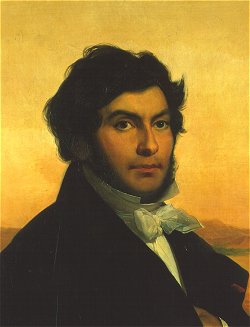
Jean-François Champollion was the French philologist and Egyptologist who deciphered the hieroglyphic script. He was born in Figeac (Lot) on 23 December 1790. When he was sixteen years old, he addressed the Academy of Grenoble about Coptic, in his opinion the language of ancient Egypt. From 1807 on, he studied under Silvestre de Sacy at the Collège de France, where at the end of his short life, from 1831 on, he would be the first to occupy the specially created chair of Egyptian history and archaeology. After he had completed his studies and the first part of 'Egypt under the Pharaohs' and 'Religion and History of Egypt and the Geography of Egypt', he was appointed lecturer at the University of Grenoble in 1809. In the meantime he had studied many languages, some of them in great depth: Hebrew, Arabic, Syriac, Chaldean, Chinese, Coptic, Ethiopian, Sanskrit, Avestic, Pahlevi, Ancient Persian, and Persian. For years he worked on the decipherment of the hieroglyphs, among other things making use of the triple text on the Rosetta Stone. In 1822 he published his famous 'Lettre à M. Dacier', in which he explained the principles of the language; only about half of the Egyptian 'alphabet' was correctly identified in this letter, however. Only later, working on his grammar and dictionary, did he develop his definitive and pioneering ideas. In the meantime he had visited various Egyptian collections and worked in the Museums of Turin, Livorno, Rome, Naples and Florence in 1824. He then became curator of the Egyptian collection in the Louvre in Paris. In 1828-1829 he visited Egypt with a team to carry out the first systematic description of the monuments. He died in 1832.